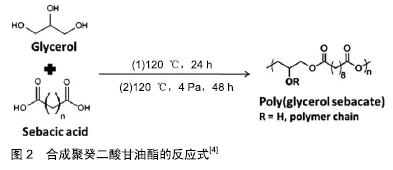Chinese Journal of Tissue Engineering Research ›› 2020, Vol. 24 ›› Issue (22): 3587-3593.doi: 10.3969/j.issn.2095-4344.2257
Previous Articles Next Articles
Synthesis of poly(glycerol sebacate) and its research hotspots
Zhou Jianpeng1, Liu Jun1, Zheng Zhangluwei1, Bao Guangjie2, Kang Hong1
- 1School of Stomatology, Lanzhou University, Lanzhou 730000, Gansu Province, China; 2Key Laboratory of Stomatology of the State Ethnic Affairs Commission, Northwest Minzu University, Lanzhou 730030, Gansu Province, China
-
Received:2019-08-14Revised:2019-08-16Accepted:2019-10-15Online:2020-08-08Published:2020-04-26 -
Contact:Bao Guangjie, Master, Professor, Key Laboratory of Stomatology of the State Ethnic Affairs Commission, Northwest Minzu University, Lanzhou 730030, Gansu Province, China Kang Hong, MD, Professor, School of Stomatology, Lanzhou University, Lanzhou 730000, Gansu Province, China -
About author:Zhou Jianpeng, School of Stomatology, Lanzhou University, Lanzhou 730000, Gansu Province, China -
Supported by:the National Natural Science Foundation of China, No. 81660189
CLC Number:
Cite this article
Zhou Jianpeng, Liu Jun, Zheng Zhangluwei, Bao Guangjie, Kang Hong. Synthesis of poly(glycerol sebacate) and its research hotspots[J]. Chinese Journal of Tissue Engineering Research, 2020, 24(22): 3587-3593.
share this article

该方法应用广泛,在合成过程中的不同条件下,不稳定产品的质量损失和羧酸组分酯化程度不同,且高温虽加速了反应动力学并使得聚合时间缩短,但却增加了甘油的蒸发,导致较低分子质量聚合物的再现,因此该方法合成的聚癸二酸甘油酯机械性能受到合成过程固化温度、甘油与癸二酸摩尔比率和固化时间几个工艺参数的影响[5]。同时合成聚癸二酸甘油酯过程中,提前聚合物(甘油和癸二酸的混合物加热一种惰性气体氛围)凝胶对聚癸二酸甘油酯的多种性能也会产生影响,对聚癸二酸甘油酯凝胶进行核磁共振光谱表征表明,凝胶的模量和极限抗拉强度随固化时间的延长和固化温度的升高而增大,而断裂伸长率降低[6]。 近年来为克服传统合成中苛刻的反应条件,改性的聚癸二酸甘油酯合成方法得以提出:①PASHNEH-TALA等[7]引入反应性丙烯酸酯基团对聚癸二酸甘油酯预聚体进行了化学改性,制备了聚癸二酸甘油酯-甲基丙烯酸酯。WANG等[8]用甲基丙烯酸2-异氰酸根合乙酯处理聚癸二酸甘油酯,得到了基于聚癸二酸甘油酯的光/热双重可固化聚合物-甲基丙烯酸酯化的聚癸二酸甘油酯。②LEE 等[9]提出一种通过微波辐射辅助固化制备多孔聚癸二酸甘油酯支架的方法。同时LAU等[10]提出微波合成技术合成的聚癸二酸甘油酯自由度更高、降解率范围更广且力学性能可调;相比于传统加热预聚合反应主要是主羟基反应,在微波条件下,甘油的一级和二级羟基均与癸二酸反应。③YEH等[11]提出运用3D打印技术合成光固化聚癸二酸甘油酯弹性体。CHEN等[12]提出通过将聚甘油癸二酸酯丙烯酸酯和聚乙二醇二丙烯酸酯或聚己内酯二丙烯酸酯在不同的丙烯酸化程度和比例下混合并3D打印出用于软组织工程的光固化聚合物。除了克服苛刻的反应条件外,实验表明各种改性方式所得到的改性聚癸二酸甘油酯及其相关产物有更高的自由度、增大的孔隙、更高的细胞黏附性及量好的生物相容性、可调的降解范围及机械属性,能形成符合需求的支架结构,具体见表1。 "


2.2 聚癸二酸甘油酯及其复合材料在组织工程中的应用 2.2.1 聚癸二酸甘油酯的相关特性 组织工程是整合细胞生物学、材料科学和手术重建的多学科领域,其目的是恢复、维持或改善组织和器官的功能。目前已经报道许多可生物降解高分子聚合物可应用于软组织工程,最常用是聚乳酸、聚己内酯和聚乳酸-羟基乙酸,然而涉及这些聚合物的应用受到其较差的机械性能和与细胞、组织有限相容性的限制。与这些材料相关的缺点包括断裂伸长率低、弹性差,在长时间接触时引发体内炎症反应和对水解的溶胀性[5]。 然而,聚癸二酸甘油酯因其优良的性能被越来越多地应用于开发支架或基质,作为各种组织工程方法中的细胞递送载体。由于人体软组织具有弹性特性,因此成功的组织工程通常需要开发具有良好顺应性(弹性)的生物可吸收材料,目的是能够维持并恢复先前的组织结构而不会对周围组织产生不利影响。聚癸二酸甘油酯具有良好的生物相容性,其生物相容性源于其合成中使用起始反应物的固有生物相容性。甘油是脂质的基本组成部分,而癸二酸是中长链脂肪酸ω-氧化的天然代谢中间体。因此,聚癸二酸甘油酯的降解产物通常能够在体内自然代谢,且含有癸二酸的甘油和共聚物已被FDA批准用于医学领域。此外,在聚癸二酸甘油酯合成过程中不使用催化剂或添加剂,这避免了在生物医学应用中可能的毒性作用。 体内与体外实验表明,聚癸二酸甘油酯具有比传统聚酯材料更好的生物学性能。WANG等[4]通过接种NIH3T3成纤维细胞于含有聚癸二酸甘油酯的玻璃培养皿中测试细胞的体外反应,选择聚乳酸-羟基乙酸作为对照,因为其常用于组织工程并且其降解时间与聚癸二酸甘油酯的降解时间相当。与聚乳酸-羟基乙酸样品相比,含有聚癸二酸甘油酯的培养皿中细胞形态正常率更高及细胞生长速率更快。同时运用大鼠进行的体内实验,发现聚癸二酸甘油酯的炎症反应与聚乳酸-羟基乙酸相似,但与聚乳酸-羟基乙酸不同,聚癸二酸甘油酯不诱导纤维囊或诱导更少的纤维囊形成。也有研究者将设计的3D聚癸二酸甘油酯支架与聚己内酯支架同时培养软骨基质细胞,结果表明3D聚癸二酸甘油酯支架上的胶原蛋白及软骨基质形成明显多于预先接种的细胞和聚己内酯支架[38]。 此外,聚癸二酸甘油酯的降解方式为表面侵蚀降解。聚癸二酸甘油酯在降解期间对水的吸收较少,没有可明显检测的溶胀,这对于小管径的组织再生极其重要,相比之下,特别是丙交酯-乙交酯和丙交酯-己内酯共聚物,经历大100%-300%的溶胀。SUNDBACK等[13]进行体内实验,通过淋巴细胞及巨噬细胞的浸润和纤维化组织厚度来评估聚癸二酸甘油酯和聚乳酸-羟基乙酸的炎症反应。结果表明聚乳酸-羟基乙酸炎症反应较聚癸二酸甘油酯重,实验中观察到对于聚癸二酸甘油酯而言,淋巴细胞浸润水平和纤维化区厚度在整个植入期间逐渐衰减;然而聚乳酸-羟基乙酸经历大量降解后,除具有显著的膨胀外,淋巴细胞浸润水平和纤维化区厚度均显著增加。因此,目前聚癸二酸甘油酯已逐渐成为应用于软组织工程的重要材料。 2.2.2 在心肌及血管组织工程中的应用 心脏修复受到再生潜能差和移植缺乏同种异体移植心脏组织的限制,心肌组织工程是一项具有前景的心脏再生方法,通过植入聚癸二酸甘油酯聚合物支架与心肌细胞结合再生,以达到修复心脏的目的。聚癸二酸甘油酯被证实是一种很有前景的能够应用于心脏组织工程的弹性聚合物[14]。目前,这一领域的研究大多集中在基于聚癸二酸甘油酯的心脏补丁开发。组织工程心脏补丁的目的是将健康的心肌细胞运送到心肌梗死区域,并提供对左心室的机械支持,聚癸二酸甘油酯底物相关复合材料支架构建体可以表现出各向异性的特性,以促进平行心肌细胞排列。同时,聚癸二酸甘油酯底物相关复合材料的刚度能与心肌刚度相匹配,从而提供与天然心脏相匹配的力学性能。此外,血管组织工程临床疗效遇到的主要挑战是仿生支架的开发,建立类似于天然血管的支架利于内皮细胞和平滑肌细胞发挥关键作用,对于血管移植物的存活具有重要意义。 KHARAZI等[15]使用顺序静电纺丝技术制造了由可增强支架血液相容性和生物相容性的聚癸二酸甘油酯/聚己内酯内层和提高支架机械性能的聚己内酯外层构成的双层小直径血管支架,用于血管组织工程。FERRARi等[16]利用静电纺丝工艺制备了直径2 mm的管状纤维移植物,具有良好的仿生机械和生物特性,可用作小直径血管移植物。以上二者的研究产物兼具最佳的表面亲水性和显著增大的孔径及抗凝血特性,且很好的支持内皮细胞和平滑肌细胞的附着、生长和浸润。LEE等[17]运用溶剂浇铸和盐浸法及静电纺丝制造的聚癸二酸甘油酯-聚己内酯-盐管,可用于小动脉移植物,其与静脉移植通畅性相似、形态学变化一致。与自体静脉移植相比,其优点在于:能使炎症快速消退并促进动脉样组织重塑、具有周向组织收缩的特性,非增殖平滑肌细胞的改造壁。HU等[14]利用微模板技术制备了一种苯胺三聚体共聚的聚癸二酸甘油酯(PGS10AT-6H)薄膜微图案电活性弹性体,其表现出能够引导鼠心肌细胞的对准和沿对准的槽/脊微图案表面延伸,并促进细胞间可用Ca2+的数量,具有良好的血液相容性、细胞相容性,可用于心脏组织工程。WU等[18]通过收集共轴电纺聚癸二酸甘油酯预聚物-聚环氧乙烷-聚乳酸纤维,后固化和脱壳,制备了一种聚癸二酸甘油酯纤维膜,其能够引导人脐动脉平滑肌细胞生长,有潜力用于制造结构各向异性的组织工程结构。MERLE等[19]的研究表明心脏贴剂聚癸二酸甘油酯/聚丁二酸丁二醇-二亚油酸酯共混膜具有轻微黏弹性,为其用于心肌组织工程提供了理论支持。然而由于聚癸二酸甘油酯缺乏电活性,设计一个具有良好机械性能和电活性的心脏组织支架仍然是一个挑战。同时,具有排列整齐的表面结构来指导细胞排列和伸长的研究,尚缺乏更多的研究数据支持,这也是研究过程中所遇到的主要问题。 2.2.3 在药物转运载体中的应用 运用某些载体局部给药可以实现药物在靶部位的局部投放,在治疗窗口内持续维持靶药物浓度,降低毒性。在药物转运的应用中,基于聚癸二酸甘油酯的复合材料因其优异的生物相容性来用作递送载体的基质或支架起到较好作用,同时其应用的基础源于其较好的药物包封能力及其释放动力学。因此,聚癸二酸甘油酯作为补充和配合的角色发挥其优良的生物学性能,用于药物转运载体方面具有良好的效果。 HSIEH等[20]通过制备含有不同量金纳米粒子的聚癸二酸甘油酯,将模拟纳米药物嵌入聚癸二酸甘油酯中,表明聚癸二酸甘油酯可以应用于包埋药物分子以用于长期药物递送。通过观察酶促降解前后聚癸二酸甘油酯中金纳米粒子浓度和分布变化及应用激光烧蚀电感耦合等离子体质谱法对聚癸二酸甘油酯降解进行研究,显示聚癸二酸甘油酯在酶解过程中不仅通过传统的表面侵蚀降解,而且可发生部分横向降解;但由于聚癸二酸甘油酯的亲水性差,以及其在体内和体外的降解和扩散受限的问题,基于聚癸二酸甘油酯开发一种适用于药物运载方面的复合材料仍然是当前研究的主要问题。NAGHIZADEH等[21]通过反向超声乳化法制备聚癸二酸甘油酯-聚乙二醇/壳聚糖-聚乙二醇包覆的氧化铁纳米颗粒的共混物,研究表明其可以用于5-氟尿嘧啶抗癌剂的载体,且可以简单地使用血液循环和外部局部磁场梯度将磁性纳米颗粒递送至期望的作用位点。DESAI等[22]介绍了一种新颖而有效的自组装椭球纳米颗粒体系,指出聚癸二酸甘油酯-聚乙二醇纳米粒子具有高细胞相容性、免疫相容性和血液相容性,可用于细胞内治疗性递送。此外,该研究结果表明椭圆形纳米粒子可广泛应用于蛋白质和肽的传递。MOLLAZADEH- MOGHADDAM等[23]利用双重封装机制首先将抗癌药物阿霉素加入聚己内酯微粒中,后将这些微粒分散在聚癸二酸甘油酯线圈中,证实线圈形聚癸二酸甘油酯可用作药物洗脱支架,且该聚癸二酸甘油酯线圈可能使采用标准血管内导管的微创递送成为可能,从而实现肿瘤化疗的局部和持续释放,以及在治疗血管疾病中的常规应用。此外,WANG等[24]合成的聚乙二醇合六亚甲基二异氰酸酯化聚癸二酸甘油酯克服了聚癸二酸甘油酯复杂的固化过程(高温和真空)和有限的亲水性(润湿角约为90°),具有良好的体内外生物相容性、韧性及生物活性,可用于控制药物和蛋白质的传递。 2.2.4 在神经引导材料中的应用 生物材料与细胞之间的相互作用在周围神经组织工程中起着重要作用,神经再生的关键是设计一种生物活性支架,模仿天然中性细胞外基质的生物和物理环境及优化的生化特性[25]。目前用于神经引导支架制备的材料大多缺乏生物活性和生物功能,导致生物材料和细胞之间的相互作用较差。因此,基于功能生物材料制备神经引导支架以增强许旺细胞分泌神经生长因子是一个重要研究方向。先前的研究中,许多天然及合成的高分子生物材料也被用于神经组织工程,如人造材料:聚乙醇酸、聚乳酸、聚乳酸-羟基乙酸、可生物降解的聚氨酯、聚有机磷腈等,但实验表明所制备的神经导管表现出不利的肿胀反应和炎症特征。由于聚癸二酸甘油酯在组织工程方面表现出良好的生物相容性,且其杨氏模量(0.28 MPa)与周围神经的杨氏模量(0.45 MPa)相当,许多神经方面的研究得以开展。使用具有与聚癸二酸甘油酯相当降解时间的聚乳酸-羟基乙酸作为对照,通过许旺细胞的直接和间接接触实体外研究发现,聚癸二酸甘油酯对细胞的代谢活性、附着或增殖没有不利影响,并且不诱导细胞凋亡。聚癸二酸甘油酯的体外作用与聚乳酸-羟基乙酸相似或更优。在体内与聚乳酸-羟基乙酸相比,聚癸二酸甘油酯显示出更有利的组织反应特征,且具有显著更少的炎症和纤维化,并且在降解期间没有可检测的肿胀反应[13]。SINGH等[26]报道了通过用甲基丙烯酸酯官能化聚癸二酸甘油酯预聚物合成聚癸二酸丙三醇酯丙烯酸甲酯导管,用于周围神经修复的分析,体内结果显示聚癸二酸丙三醇酯丙烯酸甲酯导管支持轴突的再生,轴突的定向生长与天然神经移植物相比没有表现出任何神经性疼痛的增加,并强调了该导管的灵活性、抗弯折性和抗缝合能力,突出了其在未来更大间隙模型中的潜在应用能力。ZARGAR等[27]制备的CaTiO3纳米颗粒/聚癸二酸甘油酯复合材料可用于加速周围神经再生中的轴突延伸,研究表明纳米复合材料中释放的Ca2+离子对良好的细胞反应有很大贡献,通过添加CaTiO3纳米颗粒改善聚癸二酸甘油酯的机械性质,可以控制纳米复合材料的降解速率和溶胀,这可以部分消除降解期间的炎症反应,并且有限的溶胀避免了神经压迫。SARAVANI等[28]制备了直径为80 nm的聚癸二酸甘油酯/壳聚糖/明胶(1∶1∶2)纳米复合支架,具有良好的神经引导性,被认为是神经组织工程应用的有希望的结构。HU等[25]制备的聚甲基丙烯酸甲酯-聚癸二酸甘油酯-明胶支架具有良好的生物相容性以及降解性,是能用于神经组织工程的基础材料。以上研究表明含有明胶的电纺样品具有增大、有效的孔隙率,表现出有利于细胞最大增殖而形成明显的神经组织层。WU等[29]通过微成型技术提出了基于导电的聚癸二酸甘油酯-共-苯胺五聚体聚合物微图案化导电支架。这些导电微型图象支架不仅诱导许旺细胞校准和伸长,而且显著改善神经生长因子基因的表达,其作为神经组织工程应用中的优良神经导管具有很大的潜力。 2.2.5 在皮肤及伤口敷料中的应用 皮肤组织工程要求皮肤替代品具有三维大孔结构,具有高孔隙率和孔隙互连性,以促进细胞向内生长和运输营养物质、氧气、代谢物和生长因子。皮肤组织工程的常规材料包括天然和合成材料,如胶原、海藻酸盐、壳聚糖、丝素蛋白、聚乳酸和聚己内酯。然而由于其应用尚存在一定感染风险、降解缓慢、机械性能不足和局部酸性环境的问题,这些常规材料仍然不能完全满足皮肤组织工程的要求。而聚癸二酸甘油酯具有优异的弹性和柔韧性,并具有较低的炎症反应,其降解产物是无毒的,并且可以被身体自行去除,有研究已开始将其致力于皮肤及伤口敷料方面[31]。但由于聚癸二酸甘油酯机械性能不理想、体内降解速率较快、吸水率和保水能力有限,加之其降解产物也会产生部分酸性环境,目前其在皮肤及伤口敷料方面的广泛应用还受到一定限制,研究者目前做了较多的研究工作来改善聚癸二酸甘油酯的性能,使其适用于皮肤及伤口敷料。 THANARAK等[30]报道聚癸二酸甘油酯-甲基丙烯酸酯支架可以增强人皮肤成纤维细胞的胶原生成。ZHANG等[31]通过颗粒浸出和冷冻干燥技术制备出高度互连和开放多孔的丝素蛋白微纤维/聚癸二酸甘油酯和壳聚糖/聚癸二酸甘油酯复合支架,具有高交联密度、高吸水性、低降解率、良好的细胞黏附和增殖能力,使其成为皮肤组织工程中更理想的生物材料。KEIROUZ等[32]通过无针静电纺丝技术制备了聚乙烯基吡咯烷酮和聚癸二酸甘油酯的共混物,具有机械可调性和生物相容性,可用于皮肤组织工程。同时,HEYDARI等[33]通过同轴静电纺丝工艺制备了含有辛伐他汀/环丙沙星的新型可生物降解聚癸二酸甘油酯/聚羟基丁酸酯伤口敷料,具有高抗菌活性、持久药物释放能力;结果表明对于聚癸二酸甘油酯和聚羟基丁酸酯,可以通过静电纺丝工艺以0.2∶1 mL/h的流速制造更好的核-壳纤维,同时观察到将辛伐他汀/环丙沙星药物引入可以减少纤维直径并使伤口敷料变得更亲水。AYATI等[34]制备的环丙沙星负载交联膜显示出恒定且均匀的降解速率、持久的药物释放能力、良好的细胞相容性,可作为皮肤中理想的伤口敷料。ABUDULA等[35]合成的几丁质木质素溶胶-凝胶混合物/聚癸二酸甘油酯纳米纤维支架具有良好力学性能、较好的抗菌和抗真菌活性,在伤口护理等生物医学领域具有广阔的应用前景。 2.2.6 在骨-软骨组织工程中的应用 当前对聚癸二酸甘油酯复合材料在骨-软骨组织工程方面的应用主要集中于:如何改善其机械性能和克服出现的附加且不希望的细胞反应。通过改变聚癸二酸甘油酯聚合时预聚物合成期间基础材料的摩尔比和固化时间,以及通过微加工方法创建3D设计的支架,能够使得支架性能适合于软骨组织工程[36]。 ZAKY等[37]证实聚癸二酸甘油酯弹性体通过其机械性能支持骨再生,但其更接近骨样组织而不是成熟骨。EMPPAINEN等[36]首次探索聚癸二酸甘油酯作为软骨组织工程支架材料的研究,他们设计了3D聚癸二酸甘油酯支架,使用类似设计的聚己内酯支架作为阳性对照,结果显示聚癸二酸甘油酯支架上的聚集蛋白聚糖表达高于预先接种的细胞。类似地与对照聚己内酯支架相比,聚癸二酸甘油酯支架上的胶原蛋白2与胶原蛋白1的比率(分化指数)更高。这些结果表明聚癸二酸甘油酯支架上的软骨形成基因表达比聚己内酯支架上更多,因此证实了聚癸二酸甘油酯产生软骨基质的能力。此外,LIU等[38]在体外将骨髓来源的间充质干细胞和关节软骨细胞接种于聚癸二酸甘油酯/聚己内酯支架,短期体外实验证实两种接种细胞均可在支架上黏附和增殖,且证实间充质干细胞可以在聚癸二酸甘油酯/聚己内酯支架中分化成软骨细胞样细胞并形成细胞-支架构建体的软骨培养物。TEVLEK等[39]在聚癸二酸甘油酯预聚合完成后交联阶段加入多孔β-磷酸三钙颗粒来制备双层构建体,从而创造出一种新的双层柔性结构用于骨-软组织界面,其具有防止软组织向内生长的屏障特征、用于骨再生的陶瓷相,并且适合于生长因子或药物负载;其克服了传统屏障膜如钛和钛网、聚四氟乙烯膜的一些缺点。传统屏障膜可能由于尺寸缺陷而崩塌,且需二次外科手术移除,这可能导致宿主植入部位的并发症和对新生组织损坏的潜在风险。磷酸钙支架已被广泛用作骨移植替代物,但不适的机械强度和较低的生物活性极大地妨碍其在骨组织工程中的应用。MA等[40]运用聚乙二醇化聚癸二酸甘油酯来修饰用于磷酸钙骨水泥得到磷酸钙骨水泥/聚乙二醇化聚癸二酸甘油酯复合支架,其具有高机械强度、促进细胞增殖和黏附、刺激成骨的性能,可用于骨组织工程。此外,研究表明聚乙二醇化聚癸二酸甘油酯是改性磷酸钙支架理想的可降解聚合物,聚乙二醇化聚癸二酸甘油酯包被的磷酸钙支架可能在骨组织工程领域产生良好的效果。 2.2.7 其他应用 随着有关研究的不断深入,聚癸二酸甘油酯已经不限于组织工程的研究。关于聚癸二酸甘油酯用于声带组织工程的研究目前极少,先前主要是聚己内酯和热塑性聚氨酯被用作声带折叠静电纺丝支架的主要基质材料,但研究表明其不都与人类声带组织相匹配。但JIANG等[41]制备的热塑性聚氨酯/聚癸二酸甘油酯复合膜具有模仿声带固有层细胞外基质的特性,具有好的生物相容性及亲水性且接近人类固有声带板的最大伸长,有希望用于制备声带组织工程支架。YAN等[42]合成的石墨烯-聚癸二酸甘油脂纳米复合材料其具有和人类皮肤相匹配的杨氏模量,具有高度可拉伸性和弹性,有希望用于高度可拉伸的智能材料。CHEN等[43]结合3D打印技术制作了摩擦电纳米发电机装置,其具有生物力学能量收集和自供电生理监测性能,可用于先进的电子技术,如:可穿戴设备、智能机器人、物联网和精确的医疗用途。 "

| [1] LIU Q, TIAN M, SHI R, et al. Structure and properties of thermoplastic poly (glycerol sebacate) elastomers originating from prepolymers with different molecular weights.J Appl Polym Sci.2007;104(2):1131-1137. [2] SFAKIS L, KAMALDINOV T, KHMALADZE A, et al.Mesenchymal Cells Affect Salivary Epithelial Cell Morphology on PGS/PLGA Core/Shell Nanofibers.Int J Mol Sci.2018;19(4):1031. [3] LIANG SL, COOK WD, THOUAS GA, et al.The mechanical characteristics and in vitro biocompatibility of poly (glycerol sebacate)-Bioglass elastomeric composites.Biomaterials.2010;31(33): 8516-8529. [4] WANG Y, AMEER GA, SHEPPARD BJ, et al.A tough biodegradable elastomer.Nat Biotechnol.2002;20(6):602-606. [5] RAI R, TALLAWI M, GRIGORE A, et al.Synthesis, properties and biomedical applications of poly (glycerol sebacate)(PGS): a review. Prog Polym Sci.2012;37(8):1051-1078. [6] LI Y, COOK WD, MOORHOFF C, et al.Synthesis, characterization and properties of biocompatible poly (glycerol sebacate) pre-polymer and gel.Polym Int.2013;62(4):534-547. [7] PASHNEH-TALA S, OWEN R, BAHMAEE H, et al.Synthesis, characterization and 3D micro-structuring via 2-photon polymerization of poly (glycerol sebacate)-methacrylate-an elastomeric degradable polymer.Front Phys-Beijing.2018;6(41):ISSN 2296. [8] WANG M, LEI D, LIU Z, et al.A(glycerol sebacate) based photo/thermo dual curable biodegradable and biocompatible polymer for biomedical applications.J Biomater Sci Polym Ed.2017;28(15):1728-1739. [9] LEE SH, LEE KW, GADE, PS, et al.Microwave-assisted facile fabrication of porous poly (glycerol sebacate) scaffolds.J Biomater Sci Polym Ed. 2018;29(7-9):907-916. [10] LAU CC.A comprehensive study on synthesis and bioapplication of calcium phosphates, poly (glycerol sebacate) and the biocomposite by microwave approaches.Ph.D.Thesis,University College London,US,2018. [11] YEH YC, HIGHLEY CB, OUYANG L, et al.3D printing of photocurable poly (glycerol sebacate) elastomers.Biofabrication.2016;8(4):045004. [12] CHEN JY, HWANG J, AO-IEONG WS, et al.Study of Physical and Degradation Properties of 3D-Printed Biodegradable, Photocurable Copolymers, PGSA-co-PEGDA and PGSA-co-PCLDA. Polymers. 2018;10(11):1263. [13] SUNDBACK CA, SHYU JY, WANG Y, et al.Biocompatibility analysis of poly (glycerol sebacate) as a nerve guide material.Biomaterials. 2005; 26(27):5454-5464. [14] HU T, WU Y, ZHAO X, et al.Micropatterned, electroactive, and biodegradable poly (glycerol sebacate)-aniline trimer elastomer for cardiac tissue engineering.Chem Eng J .2019;366:208. [15] KHARAZI AZ, ATARI M, VATANKHAH E, et al.A nanofibrous bilayered scaffold for tissue engineering of small-diameter blood vessels.Polym Adv Technol.2018;29(12):3151. [16] FERRARI PF, ALIAKBARIAN B, LAGAZZO A, et al.Tailored electrospun small-diameter graft for vascular prosthesis.Int J Polym Mater Po. 2017;66(12):635-643. [17] LEE KW, GADE PS, DONG L, et al.A biodegradable synthetic graft for small arteries matches the performance of autologous vein in rat carotid arteries.Biomaterials.2018;181:67-80. [18] WU HJ, HU MH, TUAN-MU HY, et al.Preparation of aligned poly (glycerol sebacate) fibrous membranes for anisotropic tissue engineering.Mat Sci eng C.2019;100:30. [19] MERLE B, KRAUS X, TALLAWI M, et al.Dynamic mechanical characterization of poly (glycerol sebacate)/poly (butylene succinate-butylene dilinoleate) blends for cardiac tissue engineering by flat punch nanoindentation.Mater Lett .2018;221:115-118. [20] HSIEH YK, CHANG CT, JEN IH, et al.Use of Gold Nanoparticles to Investigate the Drug Embedding and Releasing Performance in Biodegradable Poly (glycerol sebacate).Acs Appl Mater.2018;1(9): 4474-4482. [21] NAGHIZADEH S, HASSANZADEH NEMATI N, HASSANI NAJAFABADI A, et al.Controlled release of fluorouracil (5-FU) from chitosan-co-poly (ethylene glycol)/poly (glycerol sebacate)-co-poly (ethylene glycol)-coated iron oxide.Int J Polym Mater Po. 2018;67(4): 212-220. [22] DESAI P, VENKATARAMANAN A, SCHNEIDER R, et al. Self-assembled,ellipsoidal polymeric nanoparticles for intracellular delivery of therapeutics.J Biomed Mater Res A.2018;106(7): 2048-2058. [23] MOLLAZADEH-MOGHADDAM K, REZAEI NEJAD H, CHEN AZ, et al. Fracture-Resistant and Bioresorbable Drug-Eluting Poly (glycerol Sebacate) Coils.Adv Therapeutics.2019;2(3):1800109. [24] WANG Z, MA Y, WANG Y, et al. Urethane-based low-temperature curing, highly-customized and multifunctional poly (glycerol sebacate)- co-poly (ethylene glycol) copolymers.Acta Biomater.2018;71:279-292. [25] HU J, KAI D, YE H, et al.Electrospinning of poly (glycerol sebacate)- based nanofibers for nerve tissue engineering.Mat Sci Eng C.2017;70: 1089-1094. [26] SINGH D, HARDING AJ, ALBADAWI E, et al.Additive manufactured biodegradable poly (glycerol sebacate methacrylate) nerve guidance conduit.Acta Biomater.2018;78:48-63. [27] ZARGAR KHARAZI A, DINI G, NASER R, et al.Fabrication and evaluation of a nerve guidance conduit capable of Ca2+ ion release to accelerate axon extension in peripheral nerve regeneration.J Biomed Mater Res A.2018;106(8):2181-2189. [28] SARAVANI S, EBRAHIMIAN-HOSSEINABADI M, MOHEBBI-KALHORI D.Polyglycerol sebacate/chitosan/gelatin nano-composite scaffolds for engineering neural construct .Mater Chem Phys.2019;222:147-151. [29] WU Y, WANG L, HU T, et al.Conductive micropatterned polyurethane films as tissue engineering scaffolds for Schwann cells and PC12 cells. J Colloid Interf Sci.2018;518:252-262. [30] THANARAK J,MOHAMMED H,PASHNEH-TALA S,et al.Enhanced Collagen Production from Human Dermal Fibroblasts on Poly(glycerol sebacate)-methacrylate Scaffolds.In:2018 11th Biomedical Engineering International Conference(BMEiCON).Chiang Mai,Thailand. [31] ZHANG X, JIA C, QIAO X, et al.Silk fibroin microfibers and chitosan modified poly (glycerol sebacate) composite scaffolds for skin tissue engineering.Polym Test.2017;62:88-95. [32] KEIROUZ A, FORTUNATO G, CALLANAN A, et al.Needleless electrospinning of PVP/PGS fibrous scaffolds for skin tissue engineering applications.2018.DOI:10.31224/osf.io/xs64k [33] HEYDARI P, VARSHOSAZ J, ZARGAR KHARAZI A, et al.Preparation and evaluation of poly glycerol sebacate/poly hydroxy butyrate core-shell electrospun nanofibers with sequentially release of ciprofloxacin and simvastatin in wound dressings.Polym Adv TechnoL. 2018;29(6):1795-1803. [34] AYATI NAJAFABADI SA, SHIRAZAKI P, ZARGAR KHARAZI A, et al. Evaluation of sustained ciprofloxacin release of biodegradable electrospun gelatin/poly (glycerol sebacate) mat membranes for wound dressing applications.Asia-Pac J Chem Eng.2018;13(6):e2255. [35] ABUDULA T, GZARA L, SIMONETTI G, et al.The Effect of Poly (Glycerol Sebacate) Incorporation within Hybrid Chitin–Lignin Sol–Gel Nanofibrous Scaffolds.Materials.2018;11(3):451. [36] KEMPPAINEN JM, HOLLISTER SJ.Tailoring the mechanical properties of 3D-designed poly (glycerol sebacate) scaffolds for cartilage applications.J Biomed Mater Res A.2010; 94(1):9-18. [37] ZAKY SH, LEE KW, GAO J, et al.Poly (glycerol sebacate) elastomer supports bone regeneration by its mechanical properties being closer to osteoid tissue rather than to mature bone.Acta Biomater. 2017;54: 95-106. [38] LIU Y, TIAN K, HAO J, et al.Biomimetic poly (glycerol sebacate)/ polycaprolactone blend scaffolds for cartilage tissue engineering.J Mater Sci Mater Med.2019;30(5):53. [39] TEVLEK A, HOSSEINIAN P, OGUTCU C, et al.Bi-layered constructs of poly (glycerol-sebacate)-β-tricalcium phosphate for bone-soft tissue interface applications.Mat Sci Eng C.2017;72:316-324. [40] MA Y, ZHANG W, WANG Z, et al.PEGylated poly (glycerol sebacate)- modified calcium phosphate scaffolds with desirable mechanical behavior and enhanced osteogenic capacity.Acta Biomater. 2016;44: 110-124. [41] JIANG L, JIANG Y, STIADLE J, et al.Electrospun nanofibrous thermoplastic polyurethane/poly (glycerol sebacate) hybrid scaffolds for vocal fold tissue engineering applications.Mat Sci Eng C. 2019;94: 740-749. [42] YAN Y, POTTS M, JIANG Z, et al.Synthesis of highly-stretchable graphene–poly (glycerol sebacate) elastomeric nanocomposites piezoresistive sensors for human motion detection applications. Compos Sci Technol. 2018;16214-16222. [43] CHEN S, HUANG T, ZUO H, et al.A Single Integrated 3D-Printing Process Customizes Elastic and Sustainable Triboelectric Nanogenerators for Wearable Electronics. Adv Funct Mater.2018; 28.46:1805108. |
| [1] | Kong Yamin, Yan Juntao, Ma Bingxiang, Li Huawei. Massage vibration intervenes with MyoD expression and proliferation and differentiation of muscle satellite cells in rats with sciatic nerve injury [J]. Chinese Journal of Tissue Engineering Research, 2022, 26(8): 1160-1166. |
| [2] | Xiao Yang, Gong Liqiong, Fei Jing, Li Leiji. Effect of electroacupuncture on nerve growth factor and its receptor expression in facial nerve nucleus after facial nerve injury in rabbits [J]. Chinese Journal of Tissue Engineering Research, 2022, 26(8): 1253-1259. |
| [3] | Kan Houming, Fan Lijun, Chen Xuetai, Shen Wen. Application of platelet-rich plasma in neuropathic pain [J]. Chinese Journal of Tissue Engineering Research, 2022, 26(8): 1286-1292. |
| [4] | An Weizheng, He Xiao, Ren Shuai, Liu Jianyu. Potential of muscle-derived stem cells in peripheral nerve regeneration [J]. Chinese Journal of Tissue Engineering Research, 2022, 26(7): 1130-1136. |
| [5] | Tang Fuyu, Zhou Binbin, Wei Weibing, Zhang Hongsheng. Effect of electroacupuncture on glial fibrillary acidic protein expression at the injured site in a rat model of spinal cord injury [J]. Chinese Journal of Tissue Engineering Research, 2022, 26(26): 4113-4117. |
| [6] | Ji Hangyu, Gu Jun, Xie Linghan, Bao Junping, Peng Xin, Wu Xiaotao. Chitosan/poly(lactic-co-glycolic acid)/polylactic acid scaffold with sustained release of nerve growth factor promotes the differentiation of bone marrow mesenchymal stem cells into neurons [J]. Chinese Journal of Tissue Engineering Research, 2022, 26(25): 3974-3979. |
| [7] | Wang Kang, Zhi Xiaodong, Wang Wei. Effect and mechanism of human amniotic epithelial cells on nerve injury repair [J]. Chinese Journal of Tissue Engineering Research, 2022, 26(25): 4046-4051. |
| [8] | Qin Xuzhen, Ma Jinjin, Li Meimei, Wang Xingran, Xie Jile, Saijilafu. Effect of transient receptor potential vanilloid 4 agonist GSK1016790A on axonal regeneration [J]. Chinese Journal of Tissue Engineering Research, 2022, 26(24): 3903-3907. |
| [9] | Xiakeerzhati•Xiaohalati, Wang Xiaobei, Wang Lin. Nanoparticles: a novel strategy for the treatment of ischemic stroke [J]. Chinese Journal of Tissue Engineering Research, 2022, 26(22): 3566-3572. |
| [10] | Lu Haiping, Lang Xuemei, Zhang Cheng, Ju Songli, Zhang Yi, Wang Xin. Application of polycaprolactone modified biological barrier membrane in bone tissue engineering [J]. Chinese Journal of Tissue Engineering Research, 2022, 26(22): 3580-3585. |
| [11] | Han Zhi, Wang Zhimiao, Gaxi Sijia, Lu Qingling, Guo Tao. Tissue engineered cartilage constructed by polyurethane composite chondrocytes [J]. Chinese Journal of Tissue Engineering Research, 2022, 26(22): 3455-3459. |
| [12] | Feng Chen, Zhou Jiping, Xu Xiaodong, Jiang Yani, Shi Hongcan, Zhao Guoqi. Design of an automatic measurement system for the micro-mechanical properties of three-dimensional printing biomaterials [J]. Chinese Journal of Tissue Engineering Research, 2022, 26(21): 3306-3311. |
| [13] | Yang Lin, Wu Yao, Zhou Binbin. Interaction of Nogo-A/NgR signaling pathway and NGF/TrkA signaling pathway during the regeneration of injured spinal cord nerve axons [J]. Chinese Journal of Tissue Engineering Research, 2022, 26(20): 3220-3224. |
| [14] | Diao Yulei, Zong Xiaorui, Deng Zhibo, Shu Han. Analgesic effect of adductor canal block versus femoral nerve block after autogenous bone-tendon-bone reconstruction of the anterior cruciate ligament: an updated Meta-analysis [J]. Chinese Journal of Tissue Engineering Research, 2022, 26(2): 315-320. |
| [15] | Sun Xinzheng, Chen Xiaoke, Wang Chenghao, He Hui. Exercise improves pain induced by sciatic nerve injury in animal models: a Meta-analysis [J]. Chinese Journal of Tissue Engineering Research, 2022, 26(2): 321-328. |
| Viewed | ||||||
|
Full text |
|
|||||
|
Abstract |
|
|||||

